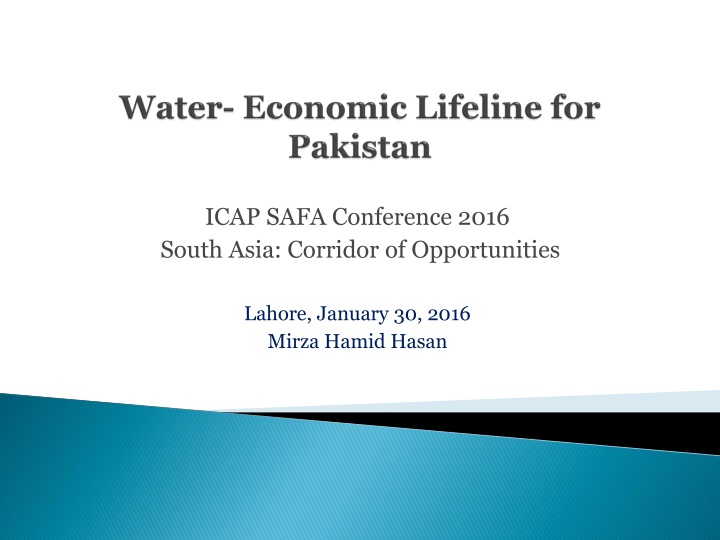
Water Scarcity and Agriculture in Pakistan: Challenges and Solutions
Discover how water scarcity is impacting Pakistan's agriculture-based economy, leading to decreasing water per capita availability. Learn about the vital role of agriculture in Pakistan, its main crops, irrigation systems, and the importance of water management for sustainable development.
Download Presentation

Please find below an Image/Link to download the presentation.
The content on the website is provided AS IS for your information and personal use only. It may not be sold, licensed, or shared on other websites without obtaining consent from the author. If you encounter any issues during the download, it is possible that the publisher has removed the file from their server.
You are allowed to download the files provided on this website for personal or commercial use, subject to the condition that they are used lawfully. All files are the property of their respective owners.
The content on the website is provided AS IS for your information and personal use only. It may not be sold, licensed, or shared on other websites without obtaining consent from the author.
E N D
Presentation Transcript
ICAP SAFA Conference 2016 South Asia: Corridor of Opportunities Lahore, January 30, 2016 Mirza Hamid Hasan
Water - life for all living beings. It is also a lifeline for all modern economies as it has large scale uses in agriculture, industry, energy, mining and construction sectors. Water has a special significance for Pakistan s agriculture-based economy. 2 1/24/2016
Availability of water per capita in Pakistan is decreasing every day due to increasing population, economic development and other factors. Pakistan s population has grown from a mere 30 million in 1947 to about 200 million in 2015. As a result, water availability has decreased from 5000 cubic metres per capita in 1951 to less than 1000 m per capita now, making us a water- scarce country. 3 1/24/2016
Agriculture is the mainstay of Pakistans economy: - 23% of GDP comes from agriculture. - It is vital for our food security. - It is the main source of sustenance for our rural population forming 55% of the whole. - Employs more than 50% of our labour force. - Supports our largest crops of wheat and cotton and large industries like textile and sugar. - Our main exports are based on agriculture. 4 1/24/2016
Most important crops are wheat, sugarcane, cotton, and rice, which together account for more than 75% of the total crop output in value. Pakistan is a net food exporter, exporting rice, cotton, fish, fruits and vegetables. As Pakistan has an arid climate its agriculture is heavily dependent on canal irrigation. Groundwater is another important source of irrigation water. 5 1/24/2016
Most of the irrigated agriculture takes place in the Indus Plain. The area is served by the largest integrated canal irrigation system in the world. It is dependent on the river Indus and its tributaries. Ninety-three percent of our harnessed water from this river system is used for irrigation. The remaining 7% meets all other needs like drinking and domestic water supply, industry, energy and environment etc. 6 1/24/2016
Pakistan receives an average of 144 Million Acre Feet (MAF) of fresh water annually from the Indus River system comprising the Indus main and its tributaries. Out of this 104 MAF is diverted to the canal irrigation system of the Indus Basin. Another 50 MAF of water used for irrigation and domestic water supply is drawn from groundwater sources. 7 1/24/2016
8 1/24/2016
The Canal Irrigation System of the Indus Basin comprises the following infrastructure: No. of major Reservoirs 3 No. of Barrages 16 No. of Head works 2 No. of Inter-River link Canals 12 No. of Canal Systems 44 9 1/24/2016
Length of Canals 56,073 km Length of Watercourses: 1.6 million km Average Canal Water Diversions 104 MAF Groundwater Abstractions 50 MAF No. of Tubewells 1 million Irrigated Area 36 million acres 10 1/24/2016
Arabian Sea 11 1/24/2016
Dwindling water availability. Inadequate storage capacity. Outdated and wasteful irrigation practices. Traditional high water consuming agricultural practices. Unregulated groundwater pumping. Water quality. Lack of water budgeting and water conservation. 12 1/24/2016
Inadequate financial resources for O&M of water infrastructure and development of water resources. Climate change impacts. Absence of regional cooperation in water resources management. 13 1/24/2016
I. Opportunities for Private Investment Building new storages. Constructing water conservation schemes. Manufacturing and installing high efficiency irrigation equipment. Manufacturing, marketing or renting agricultural equipment for raising farm water productivity. Local investment for providing low cost but hygienic bottled water for drinking. 14 1/24/2016
Opportunities for private sector to undertake O&M work of irrigation infrastructure. Job and investment opportunities emerging in climate change mitigation and adaptation projects. II. Opportunities for FDI Construction of multipurpose dams for additional storage would create FDI opportunities. Investment opportunities in renewable energy projects, necessary for climate change mitigation and adaptation. 15 1/24/2016
III. Opportunities for Regional Water Cooperation Cooperation in trans-boundary water sharing. Joint venture projects for trans-boundary water management. Trans-boundary investment in hydel energy projects on benefit-sharing basis. Cooperation in information sharing with regard to floods as well as other impacts of climate change. 16 1/24/2016
Thank You 17 1/24/2016
